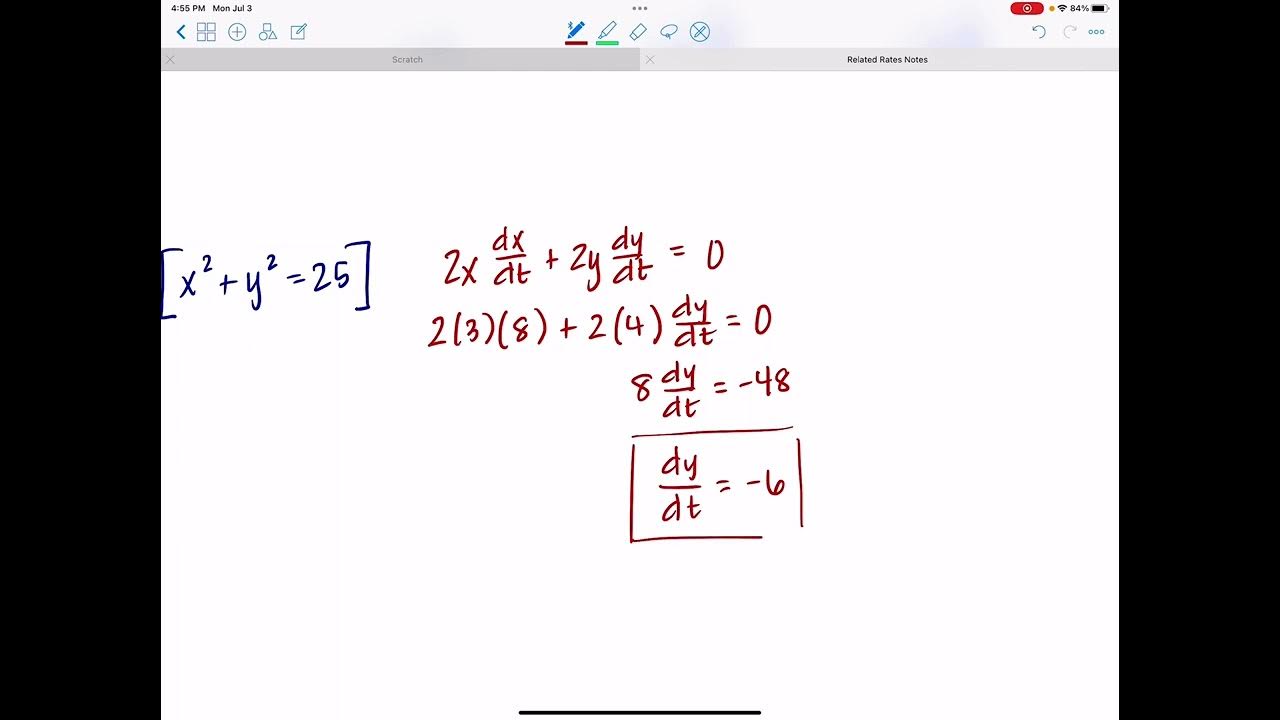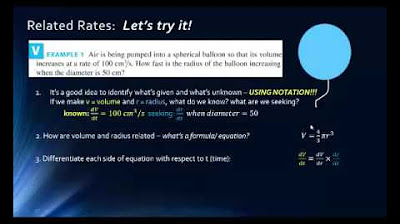How to Solve Related Rates Problems in 5 Steps :: Calculus
TLDRThis video script offers a comprehensive guide to solving related rates problems in calculus. It begins by defining related rates and outlines a five-step process for tackling such problems. The process involves drawing a diagram, labeling quantities and their rates of change, forming an equation that relates all quantities, differentiating this equation with respect to time, and finally using the derivative to find the unknown rate of change. An example problem involving a rocket launch is used to illustrate the steps, culminating in calculating the rate at which the rocket moves away from an observer. The explanation is detailed, emphasizing the application of differential calculus and the Pythagorean theorem in problem-solving.
Takeaways
- 📚 Related rates problems involve finding the rate of change of a quantity when another related rate is given.
- 🧠 These problems require the use of calculus, specifically differential calculus, to determine the rates of change.
- 📈 To solve related rates problems, five key steps have been outlined: drawing a diagram, labeling quantities and their rates, forming a related equation, differentiating with respect to time, and solving for the unknown rate.
- 🚀 An example problem discussed a rocket launch, where the goal was to find the rate at which the rocket is moving away from an observer.
- 📐 The first step in the example was to draw a diagram representing the situation, including the rocket's position and the observer's location.
- 🏢 Labeling all known and relevant quantities in the diagram is crucial, including distances and their rates of change.
- 🔢 The Pythagorean theorem was used to relate the sides of the right triangle formed in the problem, allowing for the calculation of unknown side lengths.
- 💡 Differentiating the equation (Pythagorean theorem) with respect to time using implicit differentiation is the next step to find the rates of change.
- 📌 By substituting known values and solving the differentiated equation, the unknown rate of change (C prime) can be determined.
- 📈 The final result gives the rate at which the rocket is moving away from the observer, which can be expressed in exact form or approximated as needed.
- 🎯 This method can be applied to various related rates problems by identifying the appropriate equation that relates all quantities in the problem.
Q & A
What is a related rates problem in calculus?
-A related rates problem is a type of calculus problem where you are tasked with finding the rate of change of one quantity given the rate of change of another related quantity. It typically involves the use of derivatives and is solved using differential calculus.
What are the five steps to solve a related rates problem?
-The five steps to solve a related rates problem are: 1) Draw a diagram of the situation, 2) Label all quantities and their rates of change in the diagram, 3) Choose an equation that relates all the quantities, 4) Differentiate this equation with respect to time, and 5) Use the derivative to find the rate of change of the quantity of interest.
Why is differential calculus required to solve related rates problems?
-Differential calculus is required because it deals with rates of change and slopes of curves, which are essential in determining how quantities change over time in related rates problems. By taking derivatives with respect to time, we can find the instantaneous rates of change for the quantities involved.
How does the Pythagorean theorem help in solving related rates problems involving right triangles?
-The Pythagorean theorem, which states that in a right triangle the square of the length of the hypotenuse (the side opposite the right angle) is equal to the sum of the squares of the lengths of the other two sides, provides a relationship between the sides of the triangle. This relationship can be used to set up the equation needed for differentiation in related rates problems involving right triangles.
What is the example problem discussed in the script?
-The example problem discussed is about a rocket that is launched from a launch pad and is observed from a point 5,000 meters away. When the rocket reaches an altitude of 10,000 meters, it is traveling at a rate of 200 meters per second. The problem is to find out how fast the rocket is moving away from the observer at that exact moment.
How is the distance between the observer and the launch pad related to the problem?
-The distance between the observer and the launch pad is side 'a' in the right triangle formed by the observer, the launch pad, and the rocket. This side does not change over time, so its rate of change (da/dt) is zero. It is part of the equation used to find the rate at which the rocket is moving away from the observer.
What is the rate of change of the rocket's altitude, and how is it labeled in the diagram?
-The rate of change of the rocket's altitude is given as 200 meters per second in the problem. In the diagram, it is labeled as 'B' and its rate of change is denoted as 'B prime' (dB/dt), which equals 200 meters per second.
How is the distance between the observer and the rocket (side C) calculated?
-Side C, representing the distance between the observer and the rocket, is calculated using the Pythagorean theorem. Since sides 'a' and 'b' are known (5,000 meters and 10,000 meters, respectively), applying the theorem gives C = sqrt(a^2 + b^2) = sqrt(5,000^2 + 10,000^2) = 5,000 * sqrt(5) meters.
What is the process to find the rate of change of side C (the distance the rocket is moving away from the observer)?
-The process involves differentiating the Pythagorean theorem equation (a^2 + b^2 = C^2) with respect to time to get the equation involving the rates of change (da/dt, db/dt, and dC/dt). By substituting the known values and solving for dC/dt (C prime), we find the rate at which the rocket is moving away from the observer.
What is the final answer for the rate at which the rocket is moving away from the observer?
-The final answer for the rate at which the rocket is moving away from the observer is 80 * sqrt(5) meters per second or approximately 178.9 meters per second. This is the value of C prime, representing the instantaneous rate of change of the distance between the observer and the rocket.
How can the exact rate of change be expressed in different forms?
-The exact rate of change can be expressed in its exact form as 80 * sqrt(5) meters per second, which can be rationalized to 400/sqrt(5). Multiplying the numerator and denominator by sqrt(5) gives 400 * sqrt(5)/5, which simplifies to 80 * sqrt(5). Alternatively, it can be approximated as 178.9 meters per second for a numerical value.
Outlines
📚 Introduction to Related Rates Problems
This paragraph introduces related rates problems in calculus, explaining that they involve finding a rate of change when another related rate is given. It outlines a five-step process to solve these problems and suggests that viewers can skip to the 3:15 mark for the problem example. The paragraph emphasizes the use of differential calculus to take derivatives with respect to time, using a rocket launch as an illustrative scenario where the rate of the rocket's ascent can be used to determine the rate at which it moves away from an observer.
📐 Setting Up the Problem and Drawing a Diagram
The second paragraph delves into the first two steps of solving related rates problems. It stresses the importance of drawing a diagram to visualize the problem and labeling all quantities and their rates of change. Using the rocket launch example, the speaker labels the sides of the triangle representing the launch pad, the rocket's altitude, and the distance between the observer and the rocket. The paragraph also introduces the Pythagorean theorem as a potential equation to relate quantities in right triangle scenarios.
🧮 Solving for the Rate of Change
This paragraph covers the third step of the process, which involves relating all quantities in a single equation and differentiating it with respect to time. The speaker uses the Pythagorean theorem to relate the sides of the triangle and then applies implicit differentiation to find the rate of change of the hypotenuse (side C), which represents the rocket's distance from the observer. The paragraph details the algebraic process of substituting given values and solving for the derivative of side C (C Prime), ultimately providing the rate at which the rocket is moving away from the observer at the given moment.
Mindmap
Keywords
💡Related Rates
💡Differential Calculus
💡Derivative
💡Diagram
💡Labeling
💡Pythagorean Theorem
💡Implicit Differentiation
💡Rate of Change
💡Hypotenuse
💡Observation Post
Highlights
The video describes how to solve related rates problems in calculus.
Related rates problems involve finding a rate of change when another rate is given.
Differential calculus is required to solve related rates problems.
The first step in solving a related rates problem is to draw a diagram.
The second step is to label all quantities and their rates of change in the diagram.
An equation that relates all quantities in the problem is needed, such as the Pythagorean theorem for right triangles.
Differentiate the equation with respect to time to solve related rates problems.
An example problem involves a rocket launching and moving away from an observer.
The distance between the observer and the launch pad is 5,000 meters.
The rocket's altitude at the given moment is 10,000 meters.
The rocket's speed is 200 meters per second.
The Pythagorean theorem is used to find the length of the side representing the distance from the rocket to the observer.
The derivative of the Pythagorean equation is used to find the rate of change of the rocket's distance from the observer.
The rate at which the rocket is moving away from the observer is found to be 400 over the square root of 5 meters per second.
The exact rate of change is approximately 178.9 meters per second.
Transcripts
5.0 / 5 (0 votes)
Thanks for rating:





